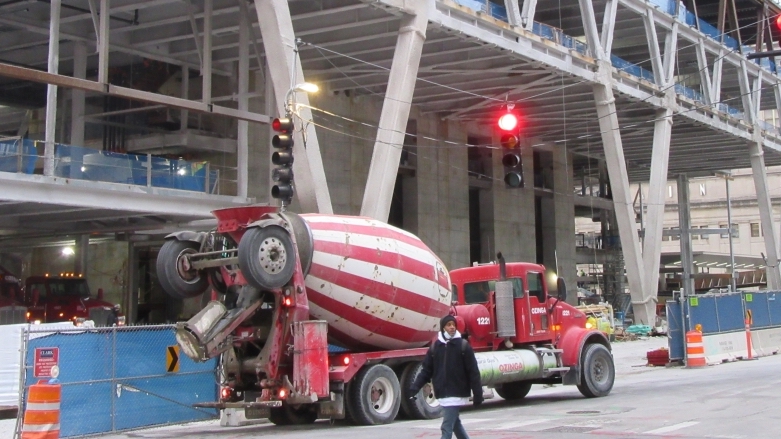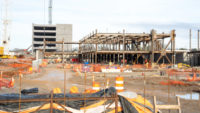John Gross of Bigane Paving Co. knows the trouble skyrocketing Chicago concrete prices have inflicted on contractors with multi-year city paving contracts.
Prices have escalated so much over the past year that the amount the city is willing to increase what it pays contractors for their material costs—based on ENR’s Chicago Construction Cost Index—is not keeping up with the actual prices.
“I’m afraid our subcontractors are going to walk,” Gross says. “I’ve heard rumors that [they’re] just not going to work for the city anymore if [they’re] not going to get an equitable adjustment.”
Supply chain-driven shortages have pushed up concrete prices nationally, but contractors in Chicago say they’ve seen some of the most severe increases. Prices appear to be pointed on a similar upward trajectory for at least the near future.
National concrete prices were up 14.8% at the end of the year compared to December 2021, according to an Associated General Contractors of America analysis of the U.S. Bureau of Labor Statistics’ Producer Price Index. But several Chicago-area contractors—as well as quotes from local concrete suppliers they shared with ENR—say prices are up by nearly 30% for some common mixes and more than 40% in some cases compared to last spring.
Cement producers and other material suppliers have faced their own cost increases.
Jim McGrath of Chicago-area concrete supplier Oremus Material says its cement and slag suppliers have gone from upping prices annually to making increases every January and July. Michelle Pollos, controller at Oremus, says its costs have risen nearly 36% in the past 18 months. Suppliers have already given notice of further increases through at least July 2024, McGrath adds.
“It hurts the supplier, it hurts the contractor, it hurts everybody because these are costs that we never had to deal with before,” McGrath says.
Cement Market Tightness
Several causes have driven concrete prices up, but one primary factor is what Ed Sullivan, chief economist and senior vice president of market intelligence for the Portland Cement Association, calls “market tightness” for cement. About half of the contiguous U.S. saw tightness in 2021. Last year, it was seen in all 48 contiguous states.
Increased demand has played a role in that tightness, Sullivan says. The past two winters saw record demand for cement amid mild weather that was favorable for construction, but that limited suppliers’ ability to build up their inventories during the cold season slowdown as they normally would to supply the busy summer construction season.
Lingering impacts of the COVID-19 pandemic compounded supply-end issues, leading to regional shortages. Delayed plant maintenance led to some cases of unexpected shutdowns, Sullivan says. Various logistics and supply chain issues also played a role, like congestion at ports and shortages of labor for hauling material.
Rising gas prices driven by outside factors prompted some concrete suppliers to add or increase fuel surcharges. According to AGC’s analysis of the Producer Price Index, the price of diesel fuel used for trucks carrying heavy loads ended the year up 20.4% from the previous December. In Chicago, rising prices pushed major supplier Prairie Materials to add a surcharge of as much as $25 per load depending on diesel prices, according to a letter it sent to its customers last May.
Last spring also saw a shortage of aggregates in the Chicago area after International Union of Operating Engineers Local 150 went on strike for seven weeks, impacting about 35 quarries across northern Illinois. The strike prompted Prairie to add a temporary aggregate surcharge of $30 per cu yd of concrete at its Chicago-area yards, although not at its other locations, the company told customers in a letter.
Barge traffic carrying materials including cement faced disruptions last year.
Dry weather across the Midwest led to portions of the Mississippi River—which carried 7.2 million tons of cement and concrete in 2019, according to the U.S. Army Corps of Engineers—dropping to record-low levels. That caused navigation impacts that slowed barge traffic, forcing the Corps to perform emergency dredging in some areas to maintain the shipping channel.
Shipping on the Illinois Waterway, which connects the Mississippi River to Lake Michigan via a system of river and canals including the Chicago and Illinois rivers, was also disrupted last year by repairs being made on Illinois River locks. The Corps says closures will continue in 2023 for additional repair work between June and September.
Put on Allocation
In some cases, cement producers have even put concrete suppliers on allocation due to shortages.
Gregg Lewis, chief communications officer for the National Ready Mixed Concrete Association, says shortages are “forcing some of them to make the hard decisions about which projects they are going to provide material for.” Suppliers have had to turn away smaller contractors, or contractors new to their area.
“That’s not a situation anybody wants to be in,” Lewis says.
Some suppliers turned to increased imports to ensure they would have materials available for contractors.
More than 25 million tons of cement and clinker were imported last year, according to the U.S. Geological Survey’s mineral commodity summaries. The net import reliance of cement consumption in the U.S. reached 21% last year, marking the largest portion of consumption that foreign cement has accounted for in at least a decade, if not ever, agency data show.
However, imported cement comes with added transportation costs. Chicago concrete supplier Ozinga, the other major supplier in northern Illinois, notified customers of an added premium of $30 per cu yd for imported cement after its local cement producer put it on allocation last August.
Outlook for 2023
Ken Simonson, AGC’s chief economist, says he expects concrete shortages will continue to be a problem as long as demand remains high. Imports may be a partial solution for some areas, but will vary by location.
“As the demand for concrete increases, particularly if [projects funded by] the money from the Infrastructure Investment and Jobs Act and these enormous [fabrication] and other manufacturing plants require a lot of concrete for slab and for associated roads or parking, then those things are going to keep pushing up demand at a time when I don’t see much supply coming in,” he says.
Portland Cement's Sullivan says there are some signs that the supply situation could be improving on the cement side, at least. This winter has not been as favorable for work so far compared to recent years, so producers may be able to rebuild their inventory. Rising interest rates have the potential to reduce private sector demand.
The World Bank has projected global economic growth to slow, which Sullivan says could mean more availability for ships and cheaper imports. But these factors likely would not impact the market until the second half of the year, at the earliest, he adds.
“If you’re looking at the conditions that led to market tightness, it suggests that maybe, if it does materialize, it won’t be quite as intense, and maybe it doesn’t grip all 48 [contiguous] states,” Sullivan says.





